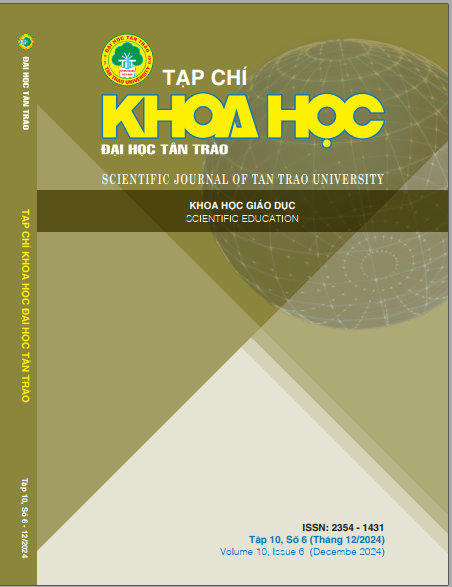CURRENT SITUATION OF GAME DESIGN USING THE STEAM APPROACH IN ORGANIZING SCIENCE EXPLORATION ACTIVITIES FOR 5-6-YEAR- OLD CHILDREN IN PRESCHOOLS IN TUYEN QUANG CITY
DOI:
https://doi.org/10.51453/2354-1431/2024/1277Abstract
Currently, the implementation of STEAM education in organizing activities for preschool children offers many advantages in education; however, there are still numerous challenges in its application. This article is based on theoretical issues and a survey on the current situation of game design using the STEAM approach in organizing science exploration activities for 5-6-year-old children in preschools in Tuyen Quang City. This study serves as a resource for preschool teachers to actively and proactively apply STEAM-based educational activities, helping to organize STEAM activities effectively.
Downloads
References
Bequette, J. W., & Bequette, M. B. (2012). A creative approach to the Common Core State Standards: The arts and STEAM. Art Education, 65(2), 40-45. https://doi.org/10.10 80/00043125.2012.11519191
Brenneman, K. (2011). Assessment for preschool science learning and learning environments. Early Childhood Research & Practice, 73(1). Retrieved from https://ecrp.uiuc.edu/v13n1/ brenneman.html
Herro, D., & Quigley, C. (2016). Innovating with STEAM in middle school classrooms: Exploring impacts on teacher beliefs and identity. Journal of Science Education and Technology, 25(6), 936-947. https://doi.
org/10.1007/s10956-016-9646-z
Nguyễn, V. A., & Trần, T. H. (2020). Ứng dụng giáo dục STEAM trong mầm non: Cơ hội và thách thức. Tạp chí Khoa học Giáo dục Việt Nam, 76(3), 12-19.
Nguyễn, T. H. (2021). Tích hợp STEAM vào chương trình mầm non tại Việt Nam: Những khó khăn và giải pháp. Tạp chí Giáo dục, 478(5), 32-38.
Phạm, H. T. (2019). Tác động của giáo dục STEAM đến sự phát triển tư duy logic của trẻ mầm non. Tạp chí Giáo dục, 456(2), 45-50.
Yakman, G. (2008). STEAM Education: An Overview of Creating a Model of Integrative Education. Proceedings of the Pupils ’ Attitudes Towards Technology Conference 2008, 12, 1-15.
Downloads
Published
How to Cite
Issue
Section
License

This work is licensed under a Creative Commons Attribution-ShareAlike 4.0 International License.
All articles published in SJTTU are licensed under a Creative Commons Attribution-ShareAlike 4.0 International (CC BY-SA) license. This means anyone is free to copy, transform, or redistribute articles for any lawful purpose in any medium, provided they give appropriate attribution to the original author(s) and SJTTU, link to the license, indicate if changes were made, and redistribute any derivative work under the same license.
Copyright on articles is retained by the respective author(s), without restrictions. A non-exclusive license is granted to SJTTU to publish the article and identify itself as its original publisher, along with the commercial right to include the article in a hardcopy issue for sale to libraries and individuals.
Although the conditions of the CC BY-SA license don't apply to authors (as the copyright holder of your article, you have no restrictions on your rights), by submitting to SJTTU, authors recognize the rights of readers, and must grant any third party the right to use their article to the extent provided by the license.


